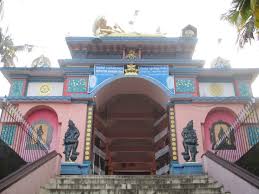Puliyur Sri Puliyur Mahavishnu Temple, Kerala

Address
Puliyur Sri Puliyur Mahavishnu Temple, Puliyur Chengannur Kollakadavu Road, Puliyoor, Kerala 689510Phone: 098251 08774
Diety
Maha Vishnu, Amman: PorrKodi Nachiyar
Introduction
The Thirupuliyur Mahavishnu Temple is a revered shrine dedicated to Lord Vishnu, situated in Puliyoor, Alappuzha District, Kerala, South India. This temple is known for its magnificent architecture, and it holds special significance in Hindu tradition. Constructed in the distinctive Kerala style of architecture, the temple is celebrated in the Divya Prabandha, an early medieval Tamil canon of the Azhwar saints who lived between the 6th and 9th centuries AD. It is one of the 108 Divyadesams dedicated to Lord Vishnu, particularly in his form as Imayavarappan. The temple also has historical connections to the Mahabharata legend. It is one of the five ancient shrines located in the Chengannur region of Kerala, and each of these temples is associated with one of the Pandava brothers from the Mahabharata. Thirupuliyur Mahavishnu Temple is attributed to Bhima, one of the Pandava brothers. These five temples were believed to have been built by the Pandavas during their exile period, and they continue to be significant pilgrimage sites for devotees seeking the blessings of Lord Vishnu in his various forms.
Puranic Significance
The Puliyur Mahavishnu Temple in Kerala, India, is steeped in legend and history, particularly in connection with the Mahabharata epic and the Pandava brothers. Here are some key aspects of the temple’s lore:
- Pandava Pilgrimage: According to legend, after the Pandava princes crowned Parikshit as the king of Hastinapura, they embarked on a pilgrimage. During this pilgrimage, each of the five Pandavas is said to have installed a deity of Lord Krishna along the banks of the river Pamba. Puliyur Mahavishnu Temple was installed by Bhima, one of the Pandava brothers.
- Bhima’s Offering: Bhima worshipped the deity at this temple, believed to be Maayapiraan, and constructed the shrine. The deity is worshipped as Krishna, and Bhima’s devotion and offerings are an integral part of the temple’s history.
- Sapta Rishis and King Virukshadharbi: In another legend, King Virukshadharbi sought to appease the Sapta Rishis to bring prosperity to his empire, which was facing difficulties, including floods and decreased wealth. However, the Sapta Rishis did not accept his offerings, suspecting that the king might be the cause of the problems. To make them accept his offerings, the king placed gold inside fruits and presented them. However, the Sapta Rishis, using their yogic powers, detected the hidden gold and rejected the offerings.
- Demon Kiruthyai: In a turn of events, the king became angry with the Sapta Rishis and tried to harm them. He even conducted a Yagna (sacrificial ritual) to summon a demon named Kiruthyai with the intention of killing the sages. Emperumaan (Lord Vishnu) intervened and sent Indra to protect the Sapta Rishis. Indra successfully defeated the demon and saved the sages. As a result, the Sapta Rishis obtained the grace of the Lord and attained liberation (Mukthi).
- Bhima’s Penance: During the Mahabharata war, Bhima underwent penance and worshipped the lord at the Puliyur Mahavishnu Temple. Bhima was known for his immense strength and power, and this temple’s size is considered a reflection of his largess. Additionally, the temple is said to house the Gatha, the weapon associated with Bhima.
These legends and historical associations add depth and significance to the Puliyur Mahavishnu Temple, making it an important pilgrimage site in the region.
Beliefs
We can pray to God to cure all chronic diseases, marriage ban, child blessing and better education. The temple is lit and worshiped, and Perumal and his mother are anointed with tulsi.
Special Features
The Puliyur Mahavishnu Temple is known for its unique features and architectural style, which reflect the serene and traditional atmosphere of Kerala. Here are some key aspects of the temple’s architecture and deity:
- Bhima’s Contribution: This temple holds special significance as it is believed to have been constructed and built by Bhima, one of the Pandava brothers from the Mahabharata. His devotion and contribution to the temple are celebrated in its history.
- Picturesque Location: The temple is situated in a tranquil and lush green setting, surrounded by natural beauty. The serene environment adds to the spiritual aura of the place.
- Traditional Kerala Architecture: The temple’s architecture follows the distinctive Kerala style, characterized by slanting roofs and the use of red Malabar tiles. This architectural style is typical of Kerala temples and adds to the temple’s aesthetic appeal.
- Entrance and Flagpost: Upon entering the temple premises, visitors pass through an archway and walk past a flagpost known as “Kodi maram,” which is traditionally covered with copper plates. The flagpost is a prominent feature of many South Indian temples and symbolizes the presence of the deity.
- Intricate Brass-Covered Pillars: Inside the temple, there is a small mandap (hall) where the pillars are adorned with intricately designed brass-plated sheets. These pillars add to the visual grandeur of the temple’s interior.
- Main Deity Mayapiran: The central sanctum of the temple houses the main deity, Mayapiran. Mayapiran is depicted in a majestic standing posture, holding a Sri Chakra in the right hand and a lotus in the left hand. Devotees come to offer their prayers and seek the blessings of Mayapiran.
The Puliyur Mahavishnu Temple not only holds historical and mythological significance but also offers a serene and spiritually uplifting experience to visitors through its unique architecture and tranquil surroundings.
Festivals
In the month of March, the flag is hoisted on the sunset star and the tenth day celebration takes place. Kavatiyattam is best celebrated on the first day of the month of Tai.
Century/Period/Age
1000-2000 years old
Managed By
Travancore Devasthanam Board
Nearest Bus Station
Puliyur
Nearest Railway Station
Chenganur
Nearest Airport
Kochi









